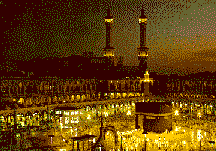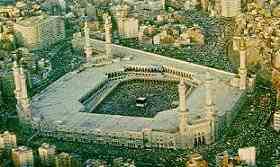 The most holy structure in Islam. Situated in Mecca, and is according to Islam, the center of the world. The Ka'ba is the qibla (Kible), the direction Muslims perform the Salat, the prayer, in. The area around the Ka'ba is considered sacred, and inside this the truce of God reigns. Man and animals are all safe here, and shall not be forced away. In the Holy Koran, it is written:
The most holy structure in Islam. Situated in Mecca, and is according to Islam, the center of the world. The Ka'ba is the qibla (Kible), the direction Muslims perform the Salat, the prayer, in. The area around the Ka'ba is considered sacred, and inside this the truce of God reigns. Man and animals are all safe here, and shall not be forced away. In the Holy Koran, it is written:
3:90 ...the first house built for mankind, was in Mecca, to bless and guide all worlds.
The base of the Ka'ba is 10.5 x 12 meters (35 x 40 feet), and it's 15 meters (49 feet) high, and is standing on a marble base, 25 centimeters (10 inches) high. Each of the corners are pointing in the four directions of the compass. It is built of grey stones from the hills around Mecca. The door of the Ka'ba is in the north-eastern wall, and is 2 meters (7 feet) above the ground. Inside the Ka'ba, three wooden pillars hold the roof up, which can be accessed by a ladder. The floor is covered by marble, and there are no furnitures, except gold and silver lamps.
East of the door, in the corner, 1,5 meters (5 feet) above the ground, the Black Stone is found. This Black Stone is now in pieces, three large parts, and smaller fragments, which are tied together with a silver band. There are several theories on the origin of the Black Stone: a meteor; lava; or basalt. The color is reddish black, with some red and yellow particles. Its original diameter is estimated to have been 30 centimeters (12 inches). There is another stone built into the western corner of the Ka'ba; the Stone of Good Fortune, which is far less sacred than the Black Stone. The wall between the door and the Black Stone is very sacred and has a lot of baraka.
The Ka'ba is covered by the kiswa, a black curtain produced traditionally in Egypt and changed annually at the time of Hajj. In an interim period, lasting a little bit more than two weeks, the Ka'ba is covered by a white covering, and it is at the end of Hajj pilgrimage that the new kiswa is presented. The tradition of the kiswa has seen many changes. Several kiswas could earlier be put over the Ka'ba, kiswas coming from everywhere, and in all possible colors.
 There is sparse information on the Ka'ba before the time of Muhammad, but it is clear that it had for centuries been used as an important religious center, by one or more polytheistic religion(s), which all are now disappeared. There are no traditional sources telling anything about its age, but according to Islam it is the first construction ever put up on earth, as it is seen out of the Koran, excerpt above. But another excerpt (2:121) says that it was Ibrahim and Ismail who raised the foundations of it. This can be understood as a reconstruction.
There is sparse information on the Ka'ba before the time of Muhammad, but it is clear that it had for centuries been used as an important religious center, by one or more polytheistic religion(s), which all are now disappeared. There are no traditional sources telling anything about its age, but according to Islam it is the first construction ever put up on earth, as it is seen out of the Koran, excerpt above. But another excerpt (2:121) says that it was Ibrahim and Ismail who raised the foundations of it. This can be understood as a reconstruction.
A fire in the Ka'ba at the time of Muhammad destroyed it partly, and the reconstruction resulted in major alterations. The size was increased, the door was put up high to prevent unwanted visitors. Rebel activities in 683 AD (64 Hegira in Islamic calendar) destroyed the Ka'ba over again, and a fire made the Black Stone split. The second reconstruction began after the removal of the old ruins. Two new doors at ground level were added. In 693 AD (74 Hegira) the new doors were removed, and the Ka'ba have had more or less the same shape and size up until now. Only small alterations and renovations have been made. Most of the stones are original from the 683 AD - structure. The Black Stone was removed from the Ka'ba, for more than 20 years in 10th century. Today some of the old doors and keys of the Ka'ba can be seen in Topkapi Palace in Istanbul; they were taken by the Ottoman sultans.
The doorkeepers of the Ka'ba are still the family Banu Shayba, which were appointed by Prophet Muhammad. In addition to being the center of hajj and Umra, the Ka'ba is the center for some smaller ceremonies. Opening of the Ka'ba, where people, men first then women, can enter is one.

